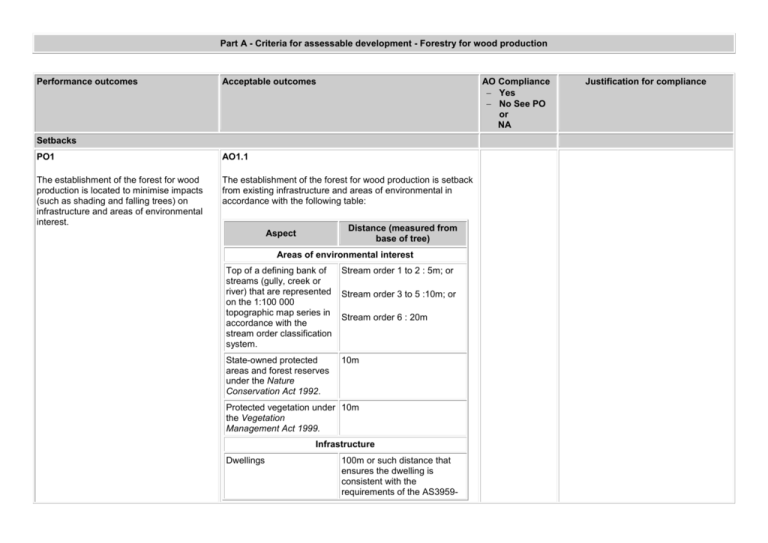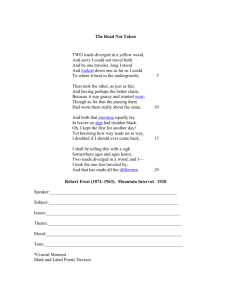Part A - Criteria for assessable development
advertisement

Part A - Criteria for assessable development - Forestry for wood production Performance outcomes Acceptable outcomes AO Compliance Yes No See PO or NA Setbacks PO1 AO1.1 The establishment of the forest for wood production is located to minimise impacts (such as shading and falling trees) on infrastructure and areas of environmental interest. The establishment of the forest for wood production is setback from existing infrastructure and areas of environmental in accordance with the following table: Distance (measured from base of tree) Aspect Areas of environmental interest Top of a defining bank of streams (gully, creek or river) that are represented on the 1:100 000 topographic map series in accordance with the stream order classification system. Stream order 1 to 2 : 5m; or State-owned protected areas and forest reserves under the Nature Conservation Act 1992. 10m Stream order 3 to 5 :10m; or Stream order 6 : 20m Protected vegetation under 10m the Vegetation Management Act 1999. Infrastructure Dwellings 100m or such distance that ensures the dwelling is consistent with the requirements of the AS3959- Justification for compliance 2009 and the Building Code of Australia. Machinery sheds 25m or 1.5 times the maximum anticipated height of the tree at harvest, whichever is the greater. Transmission lines and above-ground pipelines (excluding infrastructure servicing only the farm) not subject to an easement. 25m or 1.5 times the maximum anticipated height of the tree at harvest, whichever is the greater. AO1.2 No cultivation and planting for wood production is to occur in the setback areas identified in AO1.1above. Road and track establishment and maintenance can occur. AO1.3 Self-propagated seedlings (wildlings) generated from the forest for wood production are eradicated from the setback areas identified in AO1.1 above. Impacts on soil structure, fertility and stability PO2 AO2.1 The impacts of the forest for wood production on soil structure, fertility and stability are minimised through appropriate management of the soil. The establishment and maintenance (including associated tracks and roads) of the forest for wood production utilises one or more of the following methods: mechanical strip cultivation on the contour, spot cultivation or manual cultivation is used for establishment on slopes greater than 10 per cent and less than 25 per cent; either spot cultivation or manual cultivation is used for establishment on slopes equal to or greater than 25 per cent; tracks and roads are established away from natural drainage features and areas that are subject to erosion and landslips. AO2.2 Any part of a track or road established and maintained as part of the forest for wood production is approximately drained and adopts the following measures: establish and maintain a stable surface; drain the track or road with crossfall drainage (preferably with a slope greater than 4 percent) or by shaping the track or road to a crown so that water drains to both of its side; establish and maintain drainage structures to convey water away from the track or road formation (for example,crossdrains, mitre drains, turnouts and diversion drains or relief culverts). AO2.3 Drainage water from tracks and roads established and maintained as part of the forest for wood production is directed away from exposed soils, unstable areas, and towards undisturbed ground and areas with stable surfaces. Fire Risk PO3 AO3.1 The risk of fire to adjoining premises and infrastructure is minimised through the provision of firebreaks and fire tracks and roads. Firebreaks are established and maintained: between the forest for wood production, adjoining premises and existing infrastructure; at a minimum width form the base of the outside trees as follows: Firebreaks Forestry for wood production activities less than 40 hectares. 7m Forestry for wood production of 40 hectares to 100 hectares. 10m Forestry for wood production greater than 100 hectares. 20m, or a 10m break that is free of flammable material that is greater than 1m high followed by a 10m fuel reduction area where forestry for wood production trees are pruned up to a minimum height of 5m, commencing once trees are greater than 10m in height, that are free of flammable material that is greater than 1m high; to be accessible and trafficable for fire suppression vehicles. AO3.2 Fire access tracks and roads are established and maintained : to a minimum width of 4m; that are accessable; that ensure no part of a plantation is more than 250m from a fire access track or road. Cropping harvest, haulage and wildlife management PO4 AO4.1 Local government are informed of the expected cropping harvest cycles, volumes, timescales and haulage routes, plus propose wildfire management and location of supportive infrastructure. When the forest for wood production area is greater than 10 hectares a management report is attached to the development application that contains the following information: expected harvest cycles and estimated harvest timescale; an estimated haulage route plan identifying likely local roads for transporting the harvest to the primary destination/s; proposed methods and supporting infrastructure location for managing wild fire (including an area map of property location, adjacent roads and tracks, property entrances, location of fire access tracks and turnarounds on the property and location of water points in the area).





